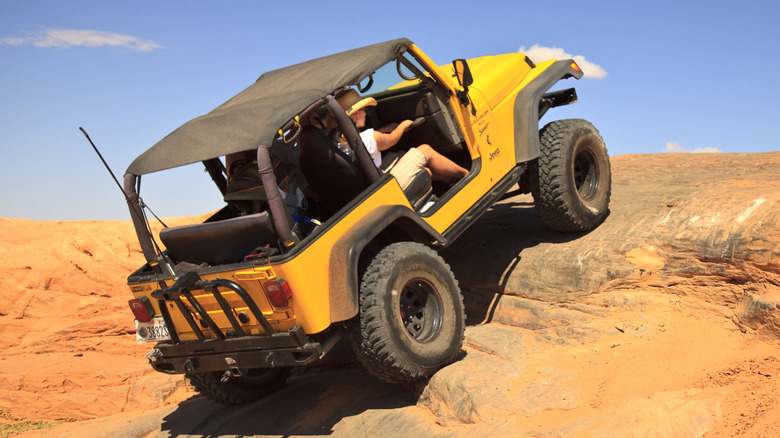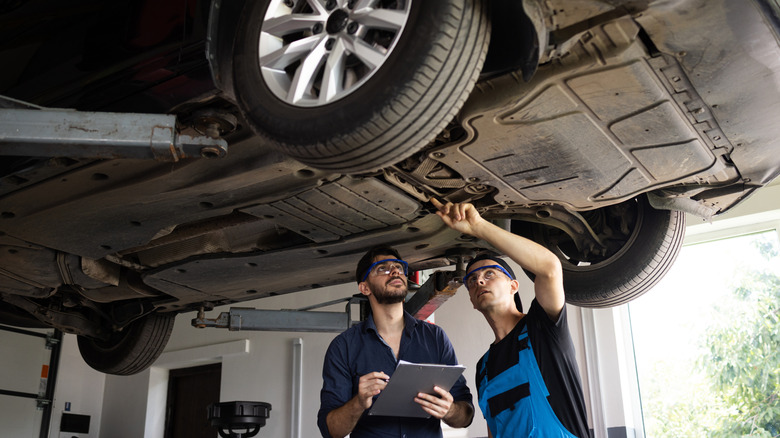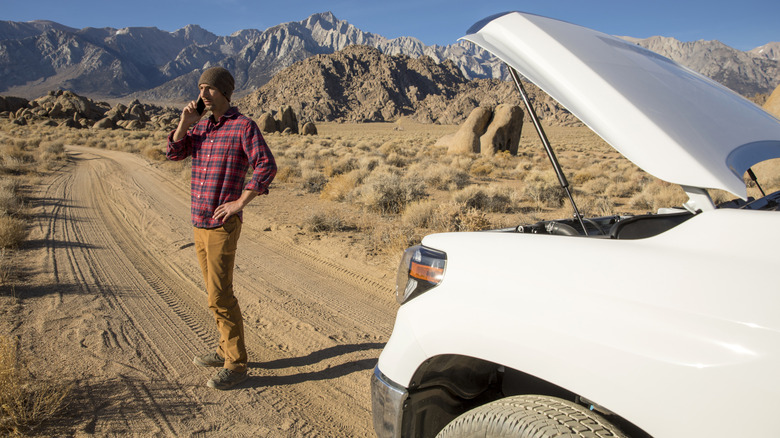Here's What May Happen If You Drive Without Your Car's Skid Plate On
Do you spend your weekends at Jeep mud runs or vacation on the Rubicon Trail in California? If so, you'll know what a skid plate is and may have asked yourself if it's really a necessary addition to your vehicle. Skid plates are panels found on the undersides of vehicles intended for off-roading and on cars that have low ground clearance. They protect the engine and oil pan, the fuel tank, the transmission, and the exhaust system. Without one, you leave these components open to damage from rocks and other debris.
If vacationing in the dirt and mud isn't your idea of fun, you'd be forgiven for assuming that all vehicles come with a skid plate. If there's a Kia or a Volvo in your garage and it looks like it has a skid plate, it's likely a mock version that the automaker has added for the sake of aesthetics.
Some vehicles come off the lot armed with skid plates ready to head onto the trail, but many off-road drivers add custom plates to their vehicles for better protection. This can be an expensive proposition, but off-roading without a skid plate can lead to a ruined day stuck in the mud and expensive damage to your vehicle.
Advantages of a skid plate when off-roading
When adding a skid plate to your vehicle, you can choose the material and thickness based on the type of driving you do. Steel plates come in 1/8-inch and 3/16-inch thickness and are the strongest and most cost-effective option. Both choices offer good protection, and the thicker 3/16-inch will protect you on even the roughest terrain. Buyers can also opt for lightweight aluminum, which is more expensive, but won't add as much bulk to your vehicle.
In addition to universal skid plates that work for a variety of vehicles, some drivers choose to add custom skid plates made just for their car. Custom plates may fit better and offer more protection, and you can also opt for specialized plates that protect only certain elements, such as your gas tank or transmission. Serious off-roading without a skid plate will leave your vehicle vulnerable to major damage, and you may even find yourself stranded if you mangle an integral part of your car on the trail.
Off-road trails are intended for vehicles but are still hazardous, with sharp rocks, tree roots, stumps, and ditches and bumps. If being free of that worry and stress isn't enough for you, you should also consider your vehicle's resale value. If you plan to sell your off-roader and upgrade, any potential buyer will want to know that the undercarriage was protected and the car's components are undamaged.
Potential pitfalls in driving with a skid plate
Adding a skid plate to your off-roading vehicle is common sense, so why would some attempt to drive without one? There are several disadvantages, including the most obvious — fuel efficiency. Skid plates add weight, especially if you go with the less expensive steel option, which can negatively affect your miles to the gallon.
Those steel plates are also vulnerable to corrosion, especially if you enjoy muddy off-roading, and regular maintenance is required. Skid plates can also make routine maintenance of your vehicle more difficult. Your skid plate may need to be removed for certain tasks, such as accessing the oil pan, but most are designed to be easily removable. The addition of a skid plate could affect your ground clearance, though the majority are made to hug the undercarriage and shouldn't make too much of an impact.
Car owners also have to consider the cost of adding a skid plate to their vehicle. A universal skid plate may cost several hundred dollars, while a custom plate can run into the thousands. That being said, if you regularly drive off-road, the benefits of a skid plate far outweigh the negatives. If you remove it, you may just want to prepare yourself with some off-road essentials for a long night stranded on the trail.


